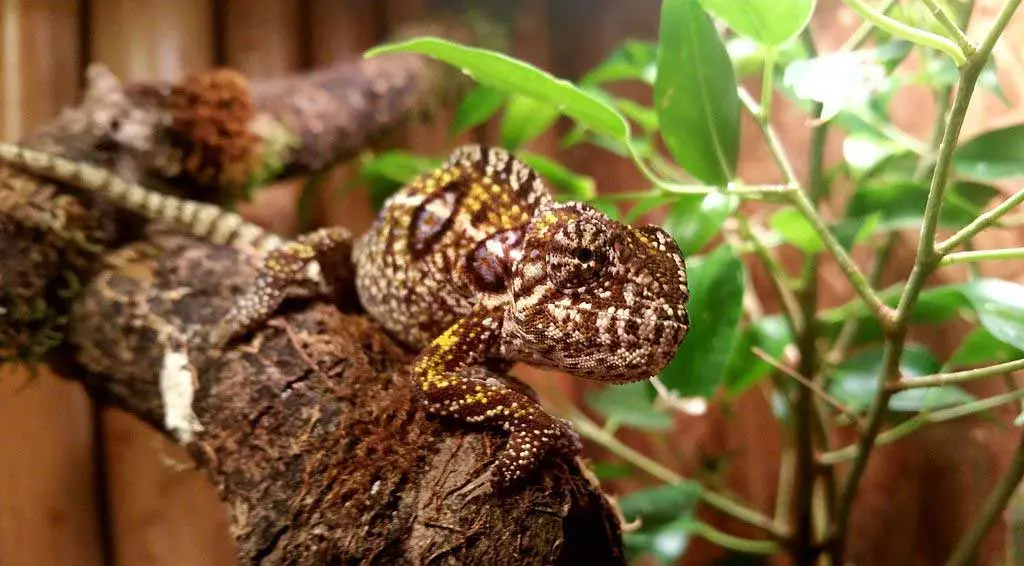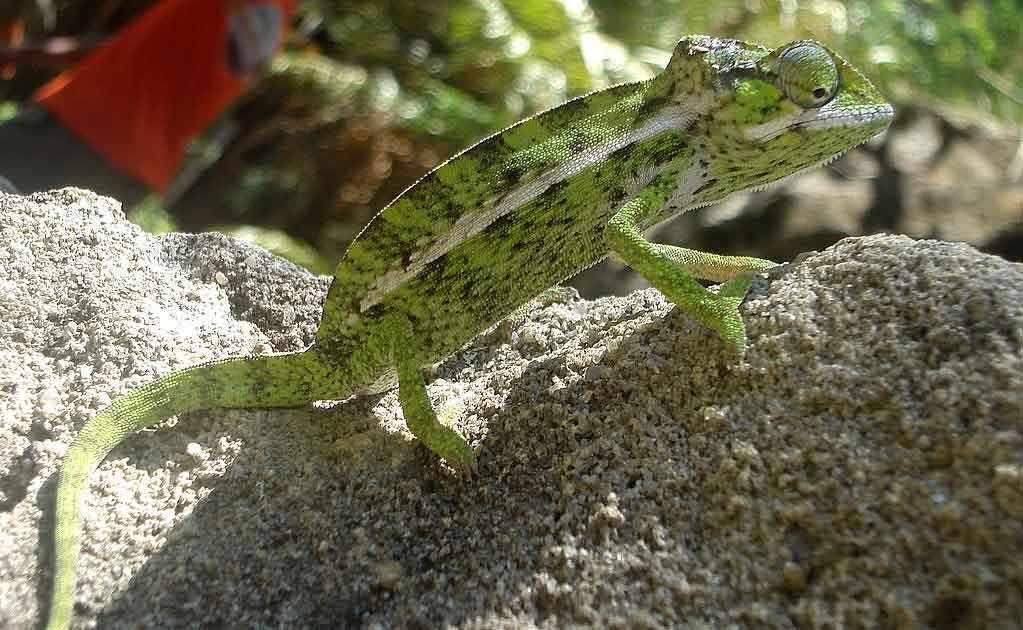
Content |
|---|
Origin / Distribution
The Carpet chameleon (Furcifer lateralis) is native to the island of Madagascar, in the Indian Ocean, and its range covers much of the island.
Characteristics / Appearance
Both males and females of the Carpet chameleon reach a maximum length of between 17 and 25 cm.. Males are generally green with a white midline and a series of dark bands extending from behind the head to the end of the tail.. Females usually have a heavier body and are more colorful (especially when pregnant), with dark bands and white or yellowish lateral ocelli and a poorly defined orange half-lateral stripe on a brownish background. The throat and lips of both sexes are usually scratched. These chameleons can change color and intensity depending on mood and certain environmental factors..
Habitat
The Carpet chameleon is strictly arboreal, and especially likes small trees and shrubs. It is usually found at an altitude of between 600 and 1200 m, usually in areas of moderate shade and high humidity, with access to direct sunlight. This species has also infiltrated the cities of Madagascar, and performs quite well in the private gardens and shrubs of the parks.
Behavior
This species, like most chameleons, is strictly diurnal. Usually, they spend the first part of the day warming their bodies by adopting a very dark coloration and exposing as much surface area as possible to sunlight.. once the desired body temperature has been reached, begin to hunt prey, activity that usually lasts the rest of the daylight hours.
- Males are very territorial and adopt a series of very elaborate postures., color changes and whistles to try to scare away rival males. They also scare away females that are not in a position to reproduce..
- The Carpet chameleon is a species that generally follows the same routine every day, to the point of sleeping on the same branch every night.
Reproduction
The Carpet chameleon matures in a very short period of time, and is usually able to reproduce by three months of age. Males are usually very territorial and usually try to attract females to their territory to mate.. Females deposit the clutches of eggs in a depression that they dig into the ground. Typical clutch size ranges from 8 and 23 eggs, and up to three clutches can be laid in a year. Incubation requires about six months at a temperature close to 24°C .
Food
The Carpet chameleon is almost entirely insectivorous, and prefers insects that normally reside in trees or shrubs. Among them are most flies, grasshoppers and crickets, as well as various insect larvae. It is also known that adult specimens consume very small lizards and even small newborn rodents (in captivity). This species hunts its food with the typical chameleon style of slowly crawling through the branches of trees or shrubs., using their excellent eyesight to detect insects. When you select the desired prey, the Carpet chameleon gets as close as possible to its prey and catches it by quickly spreading its tongue (which may be equal to the length of the lizard), capturing the insect on the sticky tip and then quickly retracting its tongue
Threats to the species
State of conservation ⓘ |
||
|---|---|---|
 Minor Concern ⓘ
(UICN)ⓘ
Minor Concern ⓘ
(UICN)ⓘ
| ||
The Carpet chameleon is a relatively popular species in the pet trade, and most of the individuals available today are bred in captivity.
Without a doubt, chameleons help control insect populations in areas where they are common.
Currently, the Carpet chameleon is found quite well in its native habitat, and even seems to benefit from some degree of habitat alteration. It has proven to be quite versatile when moving to urban areas and establishing populations there..
The "Carpet chameleon" in captivity
The Carpet chameleon, formerly known as Chamaeleo lateralis, is a beautiful species in high demand for the pet trade. Wild-caught specimens that enter the pet trade are often in poor health when they arrive at retail markets., and mortality has been very high. Captive-bred pups are easier to keep alive. These animals seem to have a relatively short lifespan even under natural conditions., and few Furcifer lateralis live more than 3 years
The terrarium
Terrarium "Carpet chameleon" |
|---|
The Carpet chameleon is reserved and shy, so it's not the kind that hangs on your shoulder. Once they are out of their habitat, can become stressed very quickly, which can cause a wide range of problems for your overall health.
These creatures prefer to be on a branch or trunk sunbathing in their enclosure. They move quietly from branch to branch, no need for space to climb. They like to stay out of sight, hiding under branches and inside hiding places.
How chameleons spend their lives in trees, you will need a terrarium taller than wide. You'll need a space that measures at least 45 x 45 x 90 centimeters for an adult—but more is always better.
The terrarium should be lined with gravel or clay granules for optimal drainage.
Temperature
Like many other cold-blooded creatures, there must be several temperatures available in the enclosure. They have to be able to regulate their body accordingly..
- Sun area: 32º – 35º
- Terrarium top: 26º – 29º
- Bottom of the terrarium: 21º – 24º
Vegetation
Chameleons need leafy, healthy plants within their enclosure to climb and shade..
Some common plants for chameleons are:
Before buying, you have to keep in mind that you will also be responsible for keeping your plants healthy, as well as your chameleon.
Humidity
Yet Carpet chameleon loves hot and humid weather. Your enclosure must maintain humidity levels between the 50% and the 60% continuously. You have to put a hydrometer in your terrarium to control the levels.
Illumination
Chameleons need lighting that mimics natural light and night cycles. They benefit considerably from double fluorescent lamps.
Food
Yet Carpet chameleon loves all kinds of tasty insects.
Among the appropriate dietary options are:
Juveniles should eat one serving of insects a day, as much as they can in one sitting. Normally, this supposes a total of some 12 insects a day.
Adults should eat every other day, and eat much less, approximately 6 insects per intake.
Health and care

The Carpet chameleon can be a very picky animal and difficult to maintain. They are ultrasensitive to stress and the environmental environment. So, one of the main things you need to do is make sure your chameleon feels as comfortable as possible..
Before you take your Carpet chameleon at home, you have to find an exotic veterinarian in your area. You can't take a reptile to traditional veterinarians, since they do not have the necessary specialization to serve them efficiently.
These chameleons are susceptible to various diseases and problems.
These are the most common problems:
If you notice any peculiar behavior or physical abnormalities, do not hesitate to take him to the veterinarian.
Reproduction
Reproduction of the "Carpet chameleon" |
|---|
If you have no experience, you may want to avoid breeding a Carpet chameleon until you've had a few. Since chameleons are so difficult to care for, their breeding can carry even more risks.
But if you are familiar with the species, can try to breed.
A good recommendation is to wait for the female to lay her first eggs before mating.. After a few weeks, you can reintroduce the female with the male. The mating of a Carpet chameleon can last up to an hour, so when it docks, be patient and don't bother.
Sperm retention is common, which means that one breeding session can fertilize several subsequent clutches. After the females put their first clutch between the 8 and 12 months, remain gravid throughout their lives.
They can give birth up to 30 offspring at the same time after a gestation of 4 to 6 months.
Buy one "Carpet chameleon"
The price of a Carpet chameleon may vary depending on several factors. But, the average cost ranges between 100 and 500 EUR. Sometimes, you can get lucky and find a person who wants to give their chameleon to a good home for free.
Keep in mind that you also need plenty of supplies to get started.. Don't skip the basics, as these are fragile creatures that need proper care.
For installation, including enclosures, the substrate, decoration, vegetation and diet, you can spend between 300 and 800 EUR.
Videos "Carpet chameleon"
Alternative names:
1. Carpet chameleon, White-lined chameleon, Jewelled Chameleon (English).
2. Caméléon à bandes latérale, Caméléon-joyau (French).
3. Teppichchamäleon (German).
4. Camaleão do tapete, Camaleão de linha branca (Portuguese).
5. "Camaleón de alfombra", Camaleón de líneas blancas (español).